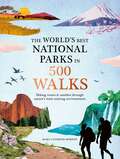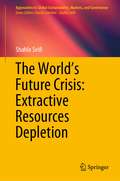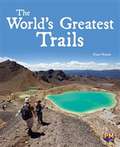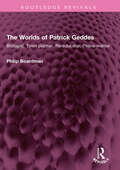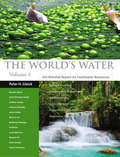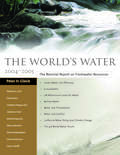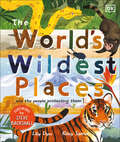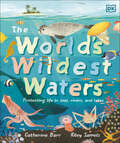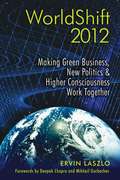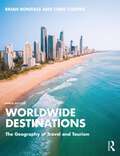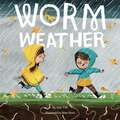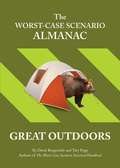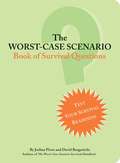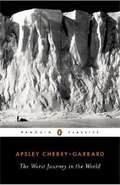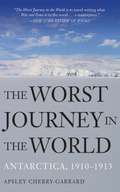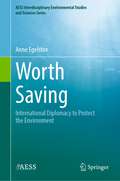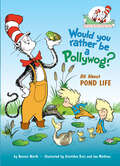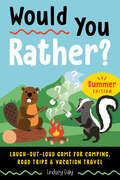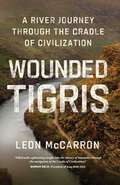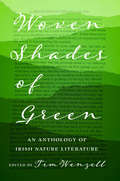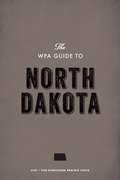- Table View
- List View
The World's Best National Parks in 500 Walks (500 Walks)
by Mary Caperton MortonAn inspiring and practical reference guide for hikers of all abilities who want to explore the world&’s national parks.Ever since Yellowstone National Park was established in 1872 as the world&’s first national park, the movement to preserve natural landscapes and habitats has spread to every continent. The World&’s Best National Parks in 500 Walks is the perfect inspiration for every explorer, from the armchair traveler to the veteran hiker, with full-color photos and vivid descriptions of some of the world&’s most spectacular hiking trails. Helpful tips on navigating the routes, planning your trips, and preparing for encounters with wildlife will have you lacing up your boots and strapping on your backpack, whether it&’s for a short weekday stroll or a multiday expedition on the world&’s most breathtaking trails.
The World’s Future Crisis: Extractive Resources Depletion (Approaches to Global Sustainability, Markets, and Governance)
by Shahla SeifiThis book focuses mainly on strategic decision making at a global level, which is rarely considered in approaches to sustainability. This book makes a unique contribution as the work looks at global consequences of mineral exhaustion and steps that can be taken to alleviate the impending problems. This book highlights how sustainability has become one of the most important issues for businesses, governments and society at large. This book explores the topic of sustainability as one that is under much debate as to what it actually is and how it can be achieved, but it is completely evident that the resources of the planet are fixed in quantity, and once used, cannot be reused except through being reused in one form or another. This is particularly true of the mineral resources of the planet. These are finite in quantity, and once fully extracted, extra quantities are no longer available for future use. This book argues and presents evidence that the remaining mineral resources are diminishing significantly and heading towards exhaustion. Once mined and consumed, they are no longer available for future use other than what can be recycled and reused. This book demonstrates that future scarcity means that best use must be made of what exists, as sustainability depends upon this, and best use is defined as utility rather than economic value, which must be considered at a global level rather than a national level. Moreover, sustainability depends upon both availability in the present and in the future, so the use of resources requires attention to the future as well as to the present. This book investigates the alternative methods of achieving the global distribution of these mineral resources and proposes an optimum solution. This book adds to the discourse through the understanding of the importance of the depletion and finiteness of raw materials and their use for the present and the future, in order to achieve and maintain sustainability.
The World's Greatest Trails (Into Reading, Level P #56)
by Diana NoonanNIMAC-sourced textbook <p><p> Hiking is a pastime enjoyed by people all over the world. Many countries have hiking trails that are famous for their length, scenery, or wildlife. Read all about some of the world's greatest trails!
The World's Largest Plants: A Book About Trees
by Susan BlackabyHear the wind rustling through the maple? See the rings on the old tree trunk? Come along on a vivid introduction to the majestic giants of the plant world.
The Worlds of Patrick Geddes: Biologist, Town planner, Re-educator, Peace-warrior (Routledge Revivals)
by Philip BoardmanFirst published in 1978, The Worlds of Patrick Geddes is a study of Patrick Geddes’ thought and action, his relationships and his life, as someone who defied labelling and who was years ahead of his contemporaries. The work of Patrick Geddes (1854-1932) is coming to be more and more widely appreciated, as his ideas on many diverse subjects are being gradually assimilated into the mainstream of modern thought. Geddes has been confidently labelled as a biologist, town-planner, sociologist and educator; but he was all of these and more. This book will be of interest to students of biology, urban planning and sociology.
The World's Water
by Peter H. GleickAmong the most compelling environmental issues of today and tomorrow are those concerning the world's fresh water resources. Peter H. Gleick's important new volume, Water in Crisis, addresses the timely and sometimes controversial aspects of world water use. At stake are water quality, quantity, and possible future conflicts over shared international water resources. Nine essays by leading specialists from fields as diverse as hydrology, zoology, and law, among others, cover such issues as the status of developments in international water law; hydroelectric power; the possible effects of climatic change on water resources; and the state of fresh water fisheries. Particular chapters explore access to clean drinking water and sanitation; the use of water for energy and food production; the quality of rivers, lakes, and inland seas; and the condition of natural aquatic ecosystems. A joint project of the Pacific Institute and the Stockholm Environment Institute, this book is a comprehensive guide to the world's fresh water resources. Hydrologists, engineers, policy makers, professionals in the environmental sciences, as well as lay readers will find Water in Crisis a dynamic resource and information-packed reference. More than 200 tables of fresh water data supplement this important volume.
The World's Water 2004-2005: The Biennial Report on Freshwater Resources (The World's Water)
by Peter H. Gleick Pacific Institute Catherine Hunt Dana Haasz Nicholas L. Cain Christine Henges-JeckThe quality and availability of fresh water are of critical importance to human and ecosystem health. Given its central role in the functioning of all living systems, water is arguably the most important of all natural resources. Produced biennially, The World's Water provides a timely examination of the key issues surrounding freshwater resources and their use. Each new volume identifies and explains the most significant current trends worldwide, and offers the best data available on a variety of water-related topics. This 2004-2005 edition of The World's Water features overview chapters on: conservation and efficiency as key tools for meeting freshwater needs; bottled water quality, costs, and trends; United Nations millennium development goals; groundwater issues; case studies of water privatization; the economic value of water; California water policy and climate change. The World's Water is the most comprehensive and up-to-date source of information and analysis on freshwater resources and the political, economic, scientific, and technological issues associated with them. It is an essential reference for water resource professionals in government agencies and nongovernmental organizations, researchers, students, and anyone concerned with water and its use.
The World's Wildest Places: And the People Protecting Them
by Lily DyuDiscover the wildest places on earth, and meet the amazing people dedicating their lives to conserving them.The World&’s Wildest Places engages adventurous and curious children with the action being taken to combat the human impact on Planet Earth. Young readers can embark on the journey of a lifetime to 20 of the world's wildest places! Explore each environment, and learn about the keepers who are working to preserve them for future generations. Meet the animals and plants who call the wilderness home, and discover how you can take active steps to make a difference. Featuring colorful original illustrations and stunning photography, The World's Wildest Places brings the excitement of the jungle and the adventure of the rainforest to your lap.This striking conversation book for kids features: - 20 incredible locations across six continents, from tropical rainforests to deserts.- Combines stunning illustrations and photography to bring the places, people and animals to life.- Accessible text providing young readers with an easy introduction to conservation and the environment.- Hide and Seek / Search and Find activities for every location make reading fun.- Highlights the conservation work that is underway across the globe.This awe-inspiring environment book is the perfect addition to the library of curious 6+ year olds with an interest in animals, adventure and exploration, alongside caregivers seeking to empower children to bring about positive change to the planet. Celebrate your child&’s curiosity as they dive into the wild and wonderful scenes of the world&’s most stunning habitats, with clear and accessible text that offers young readers an entry-point to conservation and the environment. Featuring a foreword by WLT patron and well-known naturalist Steve Backshall, this amazing animal book was developed in collaboration with World Land Trust, a conservation charity protecting the world&’s most threatened habitats.
The World's Wildest Waters: Protecting Life in Seas, Rivers, and Lakes
by Catherine BarrA beautifully presented entry point text about our oceans and other watery worlds for 6 years and upDive into the world&’s wildest oceans, lakes, and rivers, and get ready for an underwater adventure!Embark on the journey of a lifetime to 20 of the world&’s wildest waters! Explore each environment and learn about the people who are working to preserve them for future generations. Meet the creatures who call these watery worlds home and discover how you can take active steps to make a difference. Featuring colorful original illustrations and stunning photography, The World&’s Wildest Waters brings the excitement of the high seas and the mystery of the ocean&’s dark, hidden depths to your lap.
WorldShift 2012: Making Green Business, New Politics, and Higher Consciousness Work Together
by Deepak Chopra Ervin Laszlo Mikhail GorbachevA handbook for conscious change that could transform the current world crisis into planetary renewal • Outlines the problems that make today’s world prone to breakdown and suggests actions we must adopt in politics, business, and everyday life • Replaces the limited consciousness of our failing society with the holistic consciousness that is rooted in the Akashic field The deepening economic crisis and the threat posed by climate change and other social and ecological trends has caused many to despair. But with great danger comes great opportunity--the opportunity for fundamental change that will transform our societies from top to bottom. In WorldShift 2012, Ervin Laszlo brings together insights for creating sustainable positive change from spiritual leaders, scientists, and visionary businesspeople--people such as Albert Einstein, Mohammad Yunus, Václav Havel, Eckhart Tolle, Ken Wilber, David Korten, Paul Hawken, and Tomoyo Nonaka, former CEO of Sanyo Electronics. He shows how we can replace the limited consciousness of our failing society with the holistic consciousness that is reflected in the unified field of quantum physics: the Akashic field. We have an opportunity to move from the current political and business model of grow or die to a sustainable world respectful of human beings, nature, and the planet. Change on this level calls for a profound shift in consciousness and a clear understanding that--as cutting-edge physics shows--we are truly connected with each other and with the cosmos. This book presents clear evidence of this connectedness and describes the tools we need to make our world greener and our planet safer as we strive to realize the holistic consciousness of connection through the Akashic field.
Worldwide Destinations: The Geography of Travel and Tourism
by Brian Boniface Chris CooperWorldwide Destinations: The Geography of Travel and Tourism is a unique text that explores tourism demand, supply, organisation, and resources for every country worldwide in a logically structured and accessible format.The ninth edition is fully updated to include the following features: Greater exploration of current issues such as climate change, the impact of COVID-19 on destinations and subsequent recovery strategies, regenerative tourism, changes in consumer behaviour, and sustainability New and updated case studies throughout Increased emphasis on South America and a new chapter focussing on the tourism geography of Antarctica Enhanced online resources for lecturers and students including PPTs, web links, video links, MCQs, and discussion questions The first part of this book comprises thematic chapters that detail the geographic knowledge and principles required to analyse the tourism appeal of destinations. The subsequent division of this book into regional chapters enables the student to carry out a systematic analysis of a particular destination by providing insights on cultural characteristics as well as information on specific places.This volume is an invaluable resource for studying every destination in the world, explaining tourism demand, evaluating the many types of tourist attractions, and examining the trends that may shape the future geography of tourism. This thorough guide is a must-have for any student undertaking a course in travel and tourism.
The Worm Forgives the Plough
by John Stewart CollisJohn Stewart Collis was an academic and writer who took up agricultural work in his native England during World War II. In this collection of essays, he writes meditatively about the joys of nature and a life of purposeful activity in the outdoors, whether ploughing a field or thinning trees in a wood. A book about farming and nature written during World War II in England
Worm Weather (Penguin Core Concepts)
by Jean TaftDrip,drop,skip and hop.Splish, splash,sidewalk dash!It's worm weather! Join in the rainy-day fun, as kids splash through the puddles, affecting another weather enthusiast, a nearby worm. An imaginative and playful story, readers will love seeing the worm delight in the weather just as much as the kids.Worm Weather covers the concepts of Imagination and Weather.
The Worst-Case Scenario Almanac: The Great Outdoors
by Melissa Wagner David BorgenichtBears. Avalanches. Grill fires. The great outdoors is packed with perils, so be prepared from the moment you lace up your boots. With detailed instructions on how to get out of every kind of trouble in the wild, this new, dynamic almanac format in the best-selling Worst-Case Scenario series provides maximum protectionand gives you something scary to read around the campfire. Profiles of worst-case locations and intrepid explorers, charts and graphs of perilous situations, offbeat lists and factshere is all the information you need in the wilderness to feel safe and terrified at the same time.
The Worst-Case Scenario Book of Survival Questions
by David Borgenicht Joshua PivenThe authors of the phenomenally best-selling Worst-Case Scenario Survival series have taught millions to prepare for the worst--but how can readers be sure they're really ready? The Worst-Case Scenario Book of Survival Questions collects hundreds of survival dilemmas and questions designed to test true survival skill and daring. Fifty percent longer than the handbooks, this challenging, interactive, and informative book is packed with survival trivia, expert tips, adventurous situations, and illustrations. Your car is careening toward a 20-foot drop into a river: do you leap from the car immediately, or wait to swim free once it begins to sink? Is it worse to be lost in the jungle during the day or in the desert at night? If you had to perform an emergency tracheotomy, where would you make the incision? In hundreds of multiple-choice quizzes, story problems, and questions, The Worst-Case Scenario Book of Survival Questions provides need-to-know answers to life's unexpected turns for the worst. Also included is a Worst-Case Scenario Aptitude Test (WCSAT), which can be scored at home to ensure optimum readiness. Don't wait until it's too late!
Worst-Case Scenarios
by Cass R. SunsteinNuclear bombs in suitcases, anthrax bacilli in ventilators, tsunamis and meteors, avian flu, scorchingly hot temperatures: nightmares that were once the plot of Hollywood movies are now frighteningly real possibilities. How can we steer a path between willful inaction and reckless overreaction? Cass Sunstein explores these and other worst-case scenarios and how we might best prevent them in this vivid, illuminating, and highly original analysis. Singling out the problems of terrorism and climate change, Sunstein explores our susceptibility to two opposite and unhelpful reactions: panic and utter neglect. He shows how private individuals and public officials might best respond to low-probability risks of disaster—emphasizing the need to know what we will lose from precautions as well as from inaction. Finally, he offers an understanding of the uses and limits of cost–benefit analysis, especially when current generations are imposing risks on future generations. Throughout, Sunstein uses climate change as a defining case, because it dramatically illustrates the underlying principles. But he also discusses terrorism, depletion of the ozone layer, genetic modification of food, hurricanes, and worst-case scenarios faced in our ordinary lives. Sunstein concludes that if we can avoid the twin dangers of overreaction and apathy, we will be able to ameliorate if not avoid future catastrophes, retaining our sanity as well as scarce resources that can be devoted to more constructive ends.
The Worst Journey In The World
by Apsley Cherry-GarrardThe Worst Journey in the Worldrecounts Robert Falcon Scott's ill-fated expedition to the South Pole. Apsley Cherry-Garrard,the youngest member of Scott's team and one of three men to make and survive the notorious Winter Journey, draws on his firsthand experiences as well as the diaries of his compatriots to create a stirring and detailed account of Scott's legendary expedition. Cherry himself would be among the search party that discovered the corpses of Scott and his men, who had long since perished from starvation and brutal cold. It is through Cherry's insightful narrative and keen descriptions that Scott and the other members of the expedition are fully memorialized.
The Worst Journey in the World: Antarctica, 1910-1913
by Apsley Cherry-GarrardIn 1910, hoping that the study of penguin eggs would provide an evolutionary link between birds and reptiles, a group of explorers left Cardiff by boat on Robert Falcon Scott’s expedition to Antarctica. Not all of them would return. Written by one of its survivors, The Worst Journey in the World tells the moving and dramatic story of the disastrous Scott expedition. Driven by an obsession for scientific knowledge, these brave polar explorers embarked on a journey into the unknown, testing their endurance by pushing themselves to the ultimate physical and mental limits as they surveyed the striking and mammoth land that lay far to the south. Their goal was to discover as much as was scientifically possible about the terrain and habitat of Antarctica, and to be the first to reach the South Pole. The party was plagued by bad luck, weather conditions of unanticipated ferocity, and the physical deterioration of the party itself on the last part of the journey.The youngest member of the team and its sole survivor, Apsley Cherry-Garrard gives a gripping account of Scott’s last expedition. The author was also part of the rescue team that eventually found the frozen bodies of Scott and the three men who had accompanied him on the final push to the Pole. These deaths would haunt him for the rest of his life as he questioned the decisions he had made and the actions he had taken in the days leading up to the Polar Party’s demise.Prior to this sad denouement, Cherry-Garrard’s account is filled with details of scientific discovery and anecdotes of human resilience in a harsh environment. Each participant in the expedition is brought fully to life. The author’s recollections are supported by diary excerpts and accounts from other teammates.
The Worth of Water: Designing Climate Resilient Rainwater Harvesting Systems
by Liam McCarton Sean O'Hogain Anna ReidThere is no more fundamental substance to life on earth than water. Three quarter of the Earth’s surface is covered by either saltwater or freshwater, yet millions face a daily struggle to access enough water for survival. The effects of ongoing climate change have expanded the water crisis to areas previously considered water secure. This book addresses the role rainwater harvesting (rwh) can play in developing a resilient water infrastructure that will prove adaptive to climate change. The book features three sections. The first section presents the concepts underpinning a new approach to water infrastructure. The term “the worth of water” was developed to reflect the importance of the social life of water. This encompasses all human relationships with water including the social, cultural, hydrological, political, economic, technical and spiritual. A technology portfolio showcasing the worth of water from the Qanats of the ancient world to the modern Rain Cities is presented. Other concepts discussed include the circular economy of water and the concept of multiple waters for multiple users of multiple qualities. Water and its properties are a function of its peculiar molecular structure and this is illustrated in the book. Rainwater harvesting is considered by the authors as containing an inherent treatment train which functions as a complex water treatment system providing physical, chemical and biological removal mechanisms. Part two presents a new design methodology together with design templates and worked examples for the hydraulic and economic analysis of rwh systems. A state-of-the-art literature review of the potential health implications of utilizing rwh is also presented. The final section of the book discusses how rwh can play a vital role in contributing to achieving the Sustainable Development Goals and to living within the Planetary Boundaries.
Worth Saving: International Diplomacy to Protect the Environment (AESS Interdisciplinary Environmental Studies and Sciences Series)
by Anne EgelstonThis textbook is intended to be used in an upper-level international environmental issues class as part of the American Environmental Studies and Sciences book series. This class is commonly taught at both the undergraduate and graduate level as part of either an environmental studies program, a political science program, or within a policy track of an environmental science program.Given the length of time that negotiations have occurred, a new generation of students and practitioners will need to understand the complex processes that produced many of our environmental treaties. The majority of the students in environmental studies do not have a background in political science. Moving from a political science approach to an interdisciplinary approach will benefit the students by making the material more accessible.As these fields continue to grow and develop, regulatory compliance becomes increasingly important. Thus, this book is aimed at adding a business and industry perspective to this field where appropriate.
Would You Rather Be a Pollywog: All About Pond Life (Cat in the Hat's Learning Library)
by Bonnie WorthCats normally don't like water, but the Cat in the Hat is no normal puss! He’s fond of ponds, and in this latest Cat in the Hat’s Learning Library book, he takes Sally and Dick on a trip to show them how ponds are fascinating places teeming with life.From algae to snails, leeches, insects, fish, frogs, newts, turtles, ducks, swans, and more, the Cat explains how all different kinds of plants and animals make their home in and around ponds, as well as examining the difference between complete and incomplete metamorphosis and the various stages of frog development. Ideal for spring and summer reading, this is a beginning reader that will inspire kids to get outside and explore!
Would You Rather? Summer Edition: Laugh-Out-Loud Game for Camping, Road Trips, and Vacation Travel (Would You Rather?)
by Lindsey DalyHilarious questions about the joys of summer for kids who love fun, laughs, and a challenge from the author of the best-selling &“Would You Rather?&” series. School&’s out! Now you can finally relax and have an awesome vacation. And this laugh-out-loud Would You Rather? book is the perfect companion for all your favorite summer activities, whether you&’re at home, at camp, in a tent in the woods, at the pool, or on the road with family and friends. Would You Rather? Summer Edition features:· Thought-provoking scenarios that entertain and challenge kids ages 8-12 to think creatively and speak persuasively. · 160+ "Would You Rather?" questions about campfires, whitewater rafting, pool parties, rock-climbing, bottle rockets, capture the flag, and so much more. · Awesome entertainment for camping, summer camp, and road trips. · Tech-free fun for lazy summer days. · A competitive game for kids and families; who&’s the smartest of them all? Would You Rather? Summer Edition will keep you entertained and laughing in the family car, at the beach, under starry skies, in a camp cabin, or on a cozy hammock in your backyard on warm summer days and nights.
Wounded Tigris: A River Journey Through the Cradle of Civilization
by Leon McCarronA fascinating journey down the Tigris River—the lifeblood of human civilization—in search of history and hope. Starting at the source of this storied river, where ancient Mesopotamians and Assyrian kings had their images carved into stone, explorer Leon McCarron and his small team will journey through the Turkish mountains, across north-east Syria and into the heart of Iraq. Along the way, they will pass through historic cities like Diyarbakir, Mosul, and Baghdad. We will meet fishermen and farmers, along with artists, activists, and archaeologists, who rely on the flow of the river. Occasionally harassed by militias, often helped by soldiers, McCarron rode his luck in areas still troubled by ISIS and relied on the generosity of a network of strangers as he follows the river to its end in the Persian Gulf. For readers of Simon Winchester, Erika Fatland, and Kevin Fedarko, Wounded Tigris is the story of what humanity stands to lose with the death of a great river, and what can be done to try to save it.
Woven Shades of Green: An Anthology of Irish Nature Literature
by Tim WenzellWoven Shades of Green is an annotated selection of literature from authors who focus on the natural world and the beauty of Ireland. The anthology begins with the Irish monks and their largely anonymous nature poetry, written at a time when Ireland was heavily forested. A section follows devoted to the changing Irish landscape, through both deforestation and famine, including the nature poetry of William Allingham, James Clarence Mangan, essays from Thomas Gainford and William Thackerary, and novel excerpts from William Carleton and Emily Lawless. The anthology then turns to the nature literature of the Irish Literary Revival, including Yeats and Synge, but also the poetry of many others, and an excerpt from George Moore’s novel The Lake. Part four of the anthology shifts to modern Irish nature poetry, beginning with Patrick Kavanaugh, and continuing with late twentieth-century, early twenty-first-century poetry of Seamus Heaney, Eavan Boland, and others. Finally, the anthology concludes with a section on various Irish naturalist writers, and the unique prose and philosophical nature writing of John Moriarty, followed by a comprehensive list of environmental organizations in Ireland, which seek to preserve the natural beauty of this unique country. Published by Bucknell University Press. Distributed worldwide by Rutgers University Press.
The WPA Guide to North Dakota
by Federal Writers' ProjectDuring the 1930s in the United States, the Works Progress Administration developed the Federal Writers' Project to support writers and artists while making a national effort to document the country's shared history and culture. The American Guide series consists of individual guides to each of the states. Little-known authors-many of whom would later become celebrated literary figures-were commissioned to write these important books. John Steinbeck, Saul Bellow, Zora Neale Hurston, and Ralph Ellison are among the more than 6,000 writers, editors, historians, and researchers who documented this celebration of local histories. Photographs, drawings, driving tours, detailed descriptions of towns, and rich cultural details exhibit each state's unique flavor.According to the WPA Guide to North Dakota, there is more to the Northern Prairie State than meets the eye. Primarily an agricultural state, cattle ranching and the pioneer spirit are ever-present in this guide. Also, beautiful photographs of the Great Plains make this a visually pleasing guide the Peace Garden State.
